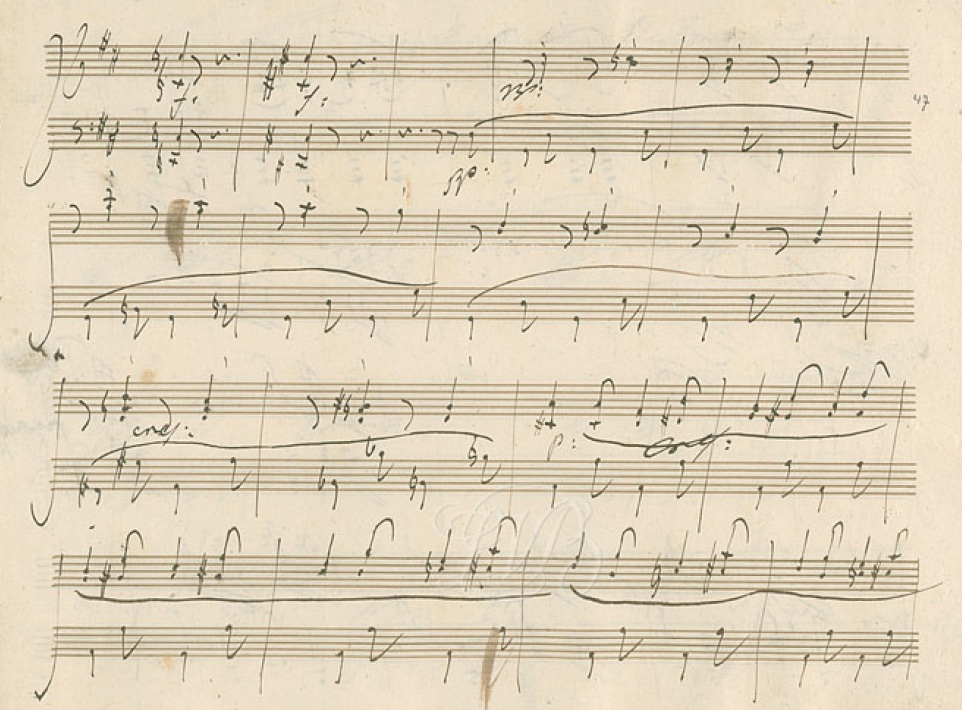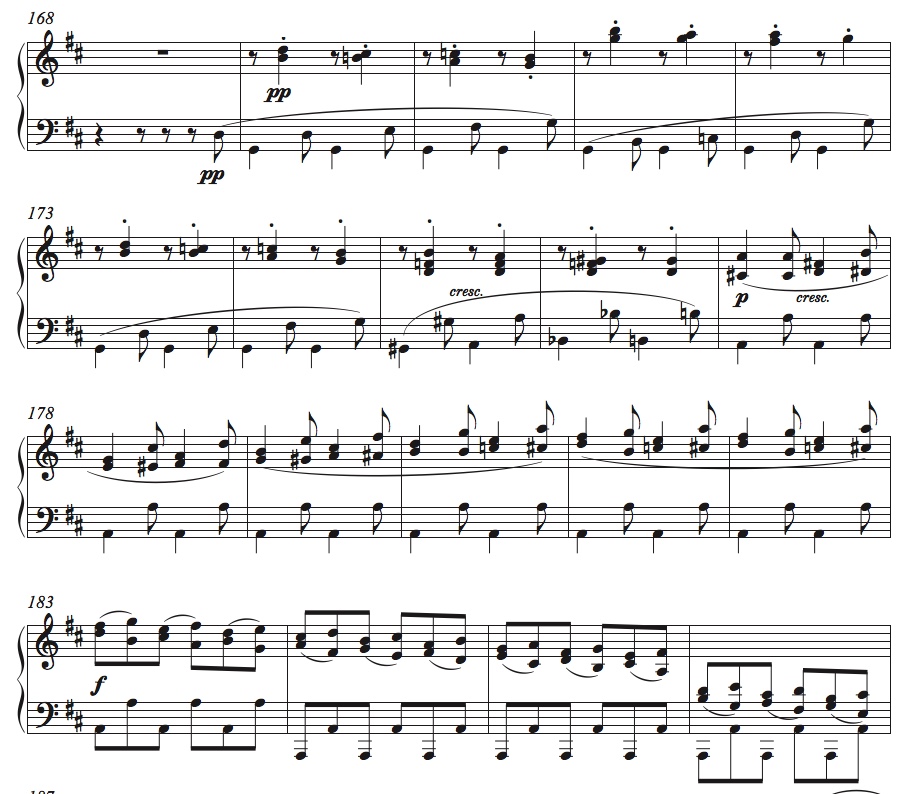Page 1 of 2
Beethoven Stems
Posted: 05 May 2019, 21:59
by John Ruggero
The following example from the last movement for Beethoven's Sonata op 28 illustrates his very musical and logical system of stem direction. This is just one of many that I am encountering as i engrave the sonatas.

- Beethoven Stems .jpeg (229.93 KiB) Viewed 9934 times
In the right hand, the same music occurs in measures. 4-5 and 8-9 of the example. But in ms. 4-5 the stems are down, in preparation for ms. 6-7. Whereas in ms. 8-9, the stems are up in preparation for the following climbing 8 measures phrase.
Note also that the stems of the left hand are down throughout. This important motive appears like this throughout the piece, sometimes all up and sometimes all down. This illustrates the fact that Beethoven avoids breaking up phrases by changing stem direction within phrases unless absolutely necessary because of spacial, extreme engraving situations, or some special musical factor. In this case, keeping the stems the same direction brings out the see-sawing oscillation between the droning bass and the climbing scale. Changing stem direction might invite holding the climbing notes through the drone in a mistaken attempt to make a continuous legato between these upper notes.
The first edition respected the left hand stemming, but not the right. None of the editions that I am using for purposes of comparison, including, Schenker, Arrau, von Bulow engraves the music as Beethoven wrote it in his autograph.
Re: Beethoven Stems
Posted: 07 May 2019, 13:11
by Florian
John, would you be willing to post a picture of your engraving of this passage? I’d be interested to see what it looks like in print.
Re: Beethoven Stems
Posted: 07 May 2019, 20:29
by John Ruggero
I'd be glad to, Florian. It is only a rough-in at this point, since I am doing the sonatas all in one go and haven't gotten into details yet.
I didn't mention the continuous up-stemming stemming of the final four measures of the original example, which again illustrates Beethoven's concern about graphic unity. The stemming abruptly changes direction in measure 183 (see example below), which is in complete harmony with what happens in the music, an abrupt tumbling downward. Then the stems shift back in measure 184 because it is the least conspicuous place to change stem direction. This change is forced by the requirement for up stems in measure 186, where the right hand moves down into the lower staff.

- Engraved Example .jpeg (221.14 KiB) Viewed 9896 times
Re: Beethoven Stems
Posted: 09 May 2019, 14:01
by Florian
Thanks, John.
In my experience we always have to make a judgement call in such cases: Does the (by modern standards) unconventional notation convey a clear additional information, or is it more distracting than useful when seen in print?
Here’s an example where the original stemming supports the direction and linearity of the music beautifully.
As an aside: Are the crescendo markings editorial additions? They look so very small.
Re: Beethoven Stems
Posted: 09 May 2019, 18:35
by Schonbergian
m. 169 - why the B

?
Re: Beethoven Stems
Posted: 09 May 2019, 19:45
by liuscorne
I guess it should be C

as in m. 173, a simple typo, no?
Re: Beethoven Stems
Posted: 09 May 2019, 23:16
by John Ruggero
Thanks, Florian, I agree. Every case must be judged on its own merits. I do feel that Beethoven's notation must be taken very seriously, however, because he does not appear to be making capricious decisions. Even where there is inconsistency, he is often experimenting and doesn't go back to correct earlier instances because he thinks the engraver will catch on. Unfortunately, they often didn't. I have also found many examples of this kind of "progressive correction" in Chopin's Etudes.
Beethoven and his engravers, who actually engraved his music more accurately than later ones, operated according to a somewhat different set of conventions than today. I think that his music is best expressed through those conventions, rather than current ones. I find many of these conventions not only more expressive and musical than our later system, but also more creative and logical. I hope to present a report on this subject in the future. But for just one example, Beethoven inserts precautionary accidentals where there is a real danger of misunderstanding, not according to mechanical rules. I posted previously about this concerning Chopin's Etudes.
Thanks Schonbergian and liuscorne, for pointing out the misprint, which is a common scanning error that I have to continually watch out for and missed in this case. As I said, this is a rough draft and hasn't undergone editing yet.
Thus the cresc.'s are by Beethoven and not editorial. I use Wess's beautiful italic font at 12 pt for expressions. It is exactly the same size as 12 pt Times New Roman. Florian, perhaps it appears small because the relative emptiness of the page? Or you prefer a larger size for expressions?
Re: Beethoven Stems
Posted: 10 May 2019, 18:26
by David Ward
John, a very minor question: I see Beethoven has a dotted crotchet (quarter) rest, but that you prefer crotchet followed by quaver (eighth). Why?
Re: Beethoven Stems
Posted: 11 May 2019, 12:28
by Florian
John Ruggero wrote: ↑09 May 2019, 23:16
Thus the cresc.'s are by Beethoven and not editorial. I use Wess's beautiful italic font at 12 pt for expressions. It is exactly the same size as 12 pt Times New Roman. Florian, perhaps it appears small because the relative emptiness of the page? Or you prefer a larger size for expressions?
Two different fonts are not necessarily "the same size" if they’re both set at 12 pt. It depends on their individual vertical metrics. I suppose the bar numbers are set in TNR 12 pt too? If so, then you should definitely use a bigger size for Wess's font to get an equivalent size. (The font is indeed very beautiful – why not use it for the bar numbers, too?) Regardless of the relation to other text fonts, I think that the crescendo markings appear too small in conjunction with the dynamic signs.
Re: Beethoven Stems
Posted: 11 May 2019, 12:47
by John Ruggero
David, the short answer is that it is another error and artifact of scanning, I would use Beethoven's notation, of course.
The long answer is that this is a interesting subject, but one that I have yet to deal with seriously. Beethoven seems to prefer the dotted quarter rest; the first editions seem to have substituted the quarter rest-eighth rest. So what does an editor do when, as in a majority of the sonatas, the manuscript no longer exists? Substitute the dotted quarter rest in all such cases assuming that that was in Beethoven's original? (We have his manuscripts for only about a third of the piano sonatas: op. 26, op 27 no. 2, op. 28, op. 53, op. 57, op. 78, op. 79, op 81a 1st mov., op. 90, op. 101, op. 109, op. 110, op. 111.) This is just one example of a central issue in editing these works. One must use a lot of detective work to determine what was actually in Beethoven's lost manuscripts.
I decided to begin to post about interesting things I am encountering as I work through the sonatas before I forget about them, but also before I am finished with the edition. Since the editing and engraving is still in a rough state, I should probably avoid posting actual engraved examples at this point, unless readers think it is still helpful despite possible errors, which could be, since in this case it brought up an interesting topic!